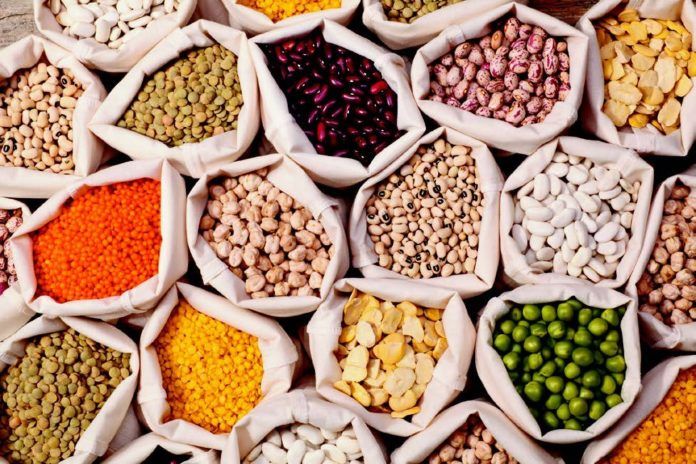Eat more plant foods…increase dietary fiber…choose natural foods over processed…get your nutrients from whole foods, not supplements. For an easy way to follow all of this sound dietary advice at the same time, simply up your intake of foods from the legume family. Legumes, which include beans, lentils, split peas, green peas, and peanuts, are thought to be one of the first cultivated crops and have been consumed by people around the world for over 10,000 years. Unfortunately, legumes are no longer a staple food in most American diets. The Dietary Guidelines for Americans recommend adults consume one to three cups of legumes per week (depending on calorie requirements), but average intake is less than one cup weekly.
Health Benefits. Legumes are a uniquely rich plant source of protein, are high in dietary fiber, and supply an impressive array of vitamins and minerals, including iron. “Like all plants, legumes also provide health-promoting antioxidants and phytochemicals,” says Micaela Karlsen, PhD, who recently received her doctorate in nutritional epidemiology from the Tufts Friedman School of Nutrition Science and Policy. “The benefits of eating legumes are numerous. In addition to their health-promoting nutrient profile, legumes fit into many traditional cuisines, and they are inexpensive.” A 2017 study by Karlsen and other Tufts’ researchers published in the journal Public Health Nutrition analyzed the diet quality of nearly 17,000 individuals and determined that adding legumes and nuts (along with reducing intake of things like added sugars and alcohol) is a good way to improve overall diet quality. Higher diet quality scores have consistently been associated with decreased risk of chronic disease.
Various epidemiological studies and controlled trials suggest that replacing meat with legumes several times a week can have a positive impact on lifespan, blood sugar control, and cardiovascular disease risk. Legume consumption has been associated with a reduced risk of colorectal cancer, and eating soybeans and soy-based products in particular is associated with reduction in LDL cholesterol levels. Legumes may even help with weight control. In a randomized controlled trial published in the Journal of the American Medical Association, participants added one cup of beans a day to their dietary intake for three months. Although they did not count calories and were not asked to remove or avoid any foods, the legume group’s 60 participants saw an average weight loss of 5.7 pounds, and measures of blood sugar control improved as well.
Anti-Health? Raw legumes, particularly beans, contain compounds such as lectins, phytates, and tannins that can interfere with digestion and absorption of some nutrients. Fortunately, soaking, boiling, sprouting, and fermenting each decrease levels of these so-called antinutrients quite significantly, increasing the bioavailability of nutrients. Studies show that boiling for as little as 10 minutes is enough to counteract anti-nutrients. Canned beans are already sufficiently heated. Dry beans should always be fully cooked before eating.
Beyond Health. The benefits of legumes extend beyond their positive impact on human health. As crops, these nitrogen-fixing plants have been used for centuries to improve the quality of soil. They also adapt well to adverse environments, are highly resistant to disease and pests, and need less water than grains.
Environmentally friendly, health-promoting, versatile, and inexpensive, legumes make a tasty and healthy addition to any meal or snack.

Try these tips for adding more satisfying, health-promoting legumes to your diet:
-Keep canned beans on hand for a quick, no-cook protein for any meal.
-Rinse canned beans to reduce sodium content (and wash away some of the gas-producing compounds).
-Soak dried beans for at least five hours, drain and add fresh water, boil at least 10 minutes to break down antinutrients, then simmer until tender. (For dry red kidney beans, the FDA recommends boiling for 30 minutes.)
-Enjoy soups that star legumes, such as split pea or lentil, but watch the sodium levels if not prepared at home.
-Toss cooked legumes into soups, stews, and chilis, or onto salads.
-Dont forget dips like hummus, white bean spread, and black bean salsa.
-Use tofu or tempeh in place of meat in stir fry dishes.
-Use refried beans or cooked black beans in tacos, burritos, and quesadillas.
-Snack on chickpeas (garbanzo beans) tossed with spices, cold or roasted.
-Try a tablespoon or two of peanut butter as a dip for carrots, celery, or apples, or spread on a banana or a slice of whole grain bread.
-Explore ethnic cuisines, where legumes like lentils are more prevalent.
-Increase intake of legumes slowly to avoid intestinal upset.

























This may be the best and most important newsletter yet. Increased protein is the key to weight loss without hunger. This is why low carb diets and low fat diets with limited carbs work.
This probably is the ounce of prevention that would have kept Ben Franklin slim.
For years, I’ve eaten 1/2 cup of canned, rinsed beans everyday, usually straight out of the can. They are tasty, high in fiber and protein and only about 100+ calories. I also eat about 6 servings of fruits and veggies everyday. That high fiber diet has certainly contributed to never having to use the word, ‘constipated’. I’m one of the lucky ones who can look forward to a healthy, feel good, bowel movement everyday.
PS I also eat a half cup of diced/stewed tomatoes everyday, which I’ve read, gives you some health insurance protection against prostate problems (lycopene).
But better if you heat up your tomatoes to liberate the lutein.😊
Namaste
Tufts university
Thank you so much for education of naive brain washed Americans like myself that animal proteins are essential.
Plant based nutrition (greens, beans and nut and selected fresh fruits) is the optimal nutrition for all.
Legumes tend to be more budget-friendly protein sources than meat – a huge consideration for the seniors and fixed-income people I have the privilege of working with.